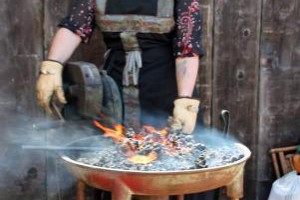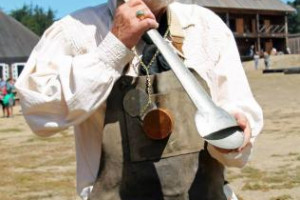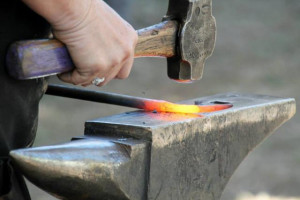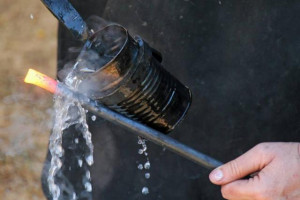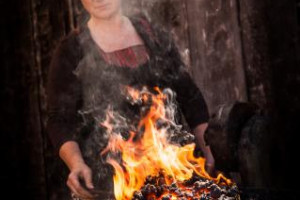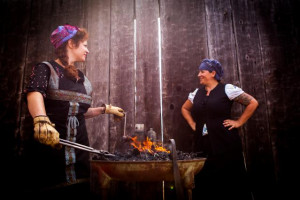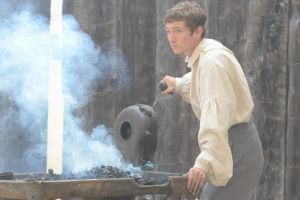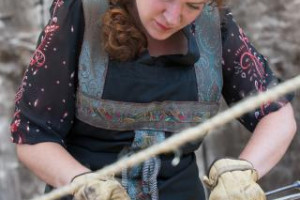Blacksmithy & Metalworks
Back to “Common Earth, Common History”
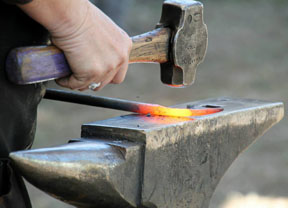
The Russian American Company brought highly skilled blacksmithing and metalworks craftspeople to California, and the Spanish missions often bought or traded with the inhabitants of Fort Ross for new items or repairs. There was a blacksmithy and a locksmithy built outside the walls of the Fort, and various blacksmiths and metalsmiths employed over time. The smiths worked on the copper and iron parts of ships that were constructed at Fort Ross, as well as longboats built for the Spaniards. A key contribution to the Fort’s agricultural endeavors was a wheat thresher that was mostly wooden, but had “iron tenons and bearings” made by the smith Semyon Mel. Some of the other metal items that were forged or repaired at Fort Ross included rifles, a copper boiler, locks, bowls, ploughshares, wheels, and pinions.
From The Khlebnikov Archive – Unpublished Journal (1800-1837) and Travel Notes (1820, 1822 and 1824), © 1990, University of Alaska Press. ISBN #0-912006-42-0
- “Mr. Schmidt also requested a decent wage for the deserving and industrious cooper Chechul’ka and the blacksmith Titov and increases for the craftsmen Ulitovskii and Samoilov, but I replied that for the time being, they should be satisfied with the recompense they received for their work on the building of the Volga, and that he himself could then write to the Chief Manager about the matter.” p.100
From So Far From Home – Russians in Early California, edited by Glenn J. Farris, © 2012, Heyday and Santa Clara University.
ISBN# 978-1-59714-184-0
- “Work during the founding was devoted solely to construction, and in the course of the year—besides the fort—they made communal barracks, a cookhouse, a blacksmithy, a locksmithy, and a shed [balagan] for goods inside the fort, and outside a bathhouse [banya] and a barn [skotnik] with a corral [prigon].” p.77
- “The following have been forwarded to Mr. Commerce Councillor Kuskov from the New Archangel Office during the Years 1812 through 1815 (accord- ing to six accountings): … tools: for carpentry, joinery, barrel-making, metalworking and blacksmithing” pp.84-85
- “Kotzebue went so far as to say that ‘the settlement of Ross brought much benefit to the Spaniards. Neither a single locksmith nor a single blacksmith is found in all of California. So all of the iron implements of the Spaniards are manufactured or repaired in the Russian colony for good payment. The [ed: Mexican] dragoons accompanying us brought many broken rifle bolts with them to be repaired’ (Kalani 2011: 222).” p.154
- “Below the hill by a landing for baidarkas [kayaks] have been built a spacious shed and a cooperage, a blacksmithy, a tannery, and a bathhouse.” p.158
- “At eleven in the morning we arrived at the colony called Ross by the Russians. It is a large square enclosure surrounded by a thick wooden pali- sade twenty feet high, strongly constructed and topped with iron spikes of proportionate size and weight. At the northeast and southwest angles are two hexagonal towers pierced with ports and loopholes. On the four sides, which correspond to the cardinal points, are four gates, each defended by a carronade of fixed breeching set in a port as on a ship. Within there were also two bronze field pieces with caissons.” p.223
- “After ordering Fort Ross demolished, M. Sutter transported by sea (to New Helvetia) by means of the sloop purchased from the Russians, the wooden houses that had been demolished and a few pieces of cast iron canon of small calibre as well as two bronze field pieces that had been presented to him by M. de Rotchev.” p.272
- “For instance, when discussing buildings down in the Fort Ross cove, the Sutter inventory speaks of ‘a forge and blacksmith shop, built of planks, 51⁄3 fathoms long by 32⁄3 arshins wide [an arshin was 28 inches wide, or 1⁄3 of a sazhen], with 4 partitions'” p.286
- “Outside the enclosure at the foot of the hill on the banks of the brook [ed: Fort Ross Creek]: 1) A forge, a shop for carpenters and locksmiths, and one for handling brass, copper and tin, built of wood 10 meters long and 6 meters wide.” p.287
Blacksmithy
From Russian California, 1806-1860, A History in Documents. Volume I, edited by James R. Gibson and Alexei A. Istomin, © 2014, The Hakluyt Society, ISBN# 9781908145062
- “Chernykh began his activities at Ross with the construction of a Scottish wooden threshing machine on the model of an iron machine that was sent there later. The thresher (powered by two horses) and a hand winnowing machine arrived at New Archangel aboard the ship Yelena in the spring of 1836, and after their wooden parts had been made there they were forwarded to Ross in the summer on the Sitkha with the metalworker and blacksmith Semyon Mel’s (a Finlander from Vyborg (Vipuri)) to help put them into operation. Iron tenons and bearings were made for his thresher, while ‘the cams on all of the wheels, as well as the teats on the gears, are of hard laurel wood, as are the conveying cylinders’ (Documents 356 and 374). Thus, the locally made and used components of Chernykh’s machine were all purely Ross manufactures.” p.47
- “Agriculture, especially pastoralism, was the forte of the Californios, not manufacturing, so they engaged the services of Russian craftsmen at Ross to make or mend various articles. During his second visit to Alta California in 1824, Captain von Kotzebue observed ‘there is no such thing as a smith in all California; consequently the making and repairing of all manner of iron implements here [Ross] is a great accommodation to them [the Californios], and affords lucrative employment to the Russians’.” p.95
- “The Russian articles taken by Khlebnikov in the summer of 1820 to trade to the Californios comprised primarily fabrics (linens, cottons, flannelette, gingham, taffeta), plus needles, locks, wool shears, iron hinges, ploughshares (made at Ross), waxen candles, clay pipes, sugar candy, and Virginia tobacco.” p.95
- “Also among the articles made for Californios or ordered by them at Ross in the first half of the 1830s were ‘two-wheeled carriages’, carts, wheels, barrels, ‘sundry furniture’, doors and sashes, ‘copper boilers’, ‘caps of red cloth’, cartridge pouches, millstones, whetstones, and so on.” p.140
- “I will inform Your Highness of the number of iron implements that the three missions of Santa Clara, San José, and San Francisco asked me to supply annually.” p.211
- “I do not intend to keep the blacksmith [Andrey] Galushin, and his demands are great; you can give a raise commensurate with his work to the Creole who can take his place so well after the building of the ship.” p.453
- “We had decided to launch mother Volga in December [1821] or at least in January [1822], but that was not to be; the launching slipway, although strengthened with 70 puds of iron, could not withstand the strong breakers, and 3 times it was broken and scattered along the shore, and it cost us much labour to repair it again in order to put it in the condition that it had before 26 December.” p.482
- “We began to mend the sails and to repair the water barrels, many iron items, and the rigging.” p.523
- “The blacksmith and his assistant, coal, bellows, tools, and an anvil have been shipped, so that there will be no delay in this respect.” p.543
From Russian California, 1806-1860, A History in Documents. Volume II, edited by James R. Gibson and Alexei A. Istomin, © 2014, The Hakluyt Society, ISBN# 9781908145079
- “The copper boiler is being repaired, and although you wrote that it should only be soldered, after having dismantled it we saw that it had been burned through in many places and needed repairs, as well as a completely new lid so that it would require just as much time to repair it as to make a new one. We will send it to Monterrey on the Yelena if we manage to repair it by the time the ship arrives.” p.59
- “We obtained a full cargo for the Baykal with the help of your umiak, and now I am sending it back. As ballast we had 200 puds of iron, of which I am sending you 50 bars, and the remaining 59 bars I am leaving with Father Tomás so that in the event of the dispatch of the umiak to the port [Bodega] you will get it.” p.152
- “At present we urgently need the following materials: gunpowder, large nails, old ropes or cables, glass, turpentine, vegetable oil or drying oil, wide bar iron, soft steel, steel, and axes. I beg you most humbly, is it not possible to spare any of these things from your cargo?” p.163
- “At the mouth of the Slavyanka River there are whole blocks of greenstone with particles of granite, and upriver they have found iron ore. Obsidian, serpentine, and hornblende are found in various places on the surface of the hills. Pure grains of iron are cast by the sea onto the sandy beach.” p.187
- “Crocks could be used beneficially throughout the colonies, where copper pots are common; as they often lose their tinning, and copper – as is well known – is toxic, the use of such pots is unquestionably harmful. An experienced craftsman could make not only pots but also plates, mugs, bowls, and other small items that are needed everywhere, and for want of simple ones they buy costly ones.” p.189
- “Father Ventura has asked that you make 50 ploughshares, 6 pairs of wheels, 4 6-vedro, 4 12- vedro, and 4 20-vedro barrels, some picks for dressing millstones, a blacksmith’s vice [upornaya natyazhka], and a boot-tree [nakolodka] for the mission.” p.141
- “We have been deprived of the blacksmith Dmitry Samoylov1 who died from the effects of catarrh.” p.208
- “The Creole blacksmith Leonty Ostrogin is being sent to Ross on the brig Polifem so that the counter will be diligent in satisfying the Californian missions by fixing and making things that they order, such as wheels, dishes, implements, and rowing vessels, striving not only to make things in the fastest possible time but also to make them well. The blacksmith has been allotted a salary of 400 rubles a year, starting with the day of commencement of his work as a blacksmith.” p.214
- “These men said that [at a distance of ] 15 days of travel from the settlement [to the north] the Indians have many otters, both sea and land, and would willingly sell them for iron knives and other things.” p.278
- “In fulfilment of the order to this counter from the governor of the colonies of 16 May of this year, no. 325, it is to send all of the bricks, laurel wood, wooden shingles, and old iron and copper articles that have been readied and add as much grain as space permits.” p.279
- “A longboat has been sent in pieces on the Urup for the purpose of conveying wheat from the missions and elsewhere to our ships at San Francisco. This longboat must now be assembled at Ross, braced, and sheathed with copper, and for this Bykov and Uimoin, good carpenters who understand this business, have been sent; the counter will return them to New Archangel on the first transport this autumn. Old tarred canvas – from, say, the unfit sails of umiaks – must be put under the copper.” pp.328-329
- “The metal worker [Semyon] Mel’s [possibly Simon Mellius]3 is being sent to help with the installation of the machines. When he is no longer needed, the counter is to send him back to New Archangel.” p.357
- “On the sloop Sitkha, which will soon set off fot Bodega Bay, I am assigning for dispatch from this port for service at the settlement of Ross the following employees of the Company: Semyon Mel’s (metalsmith)…” p.410
- “Mr Chernykh made iron wheels and pinions for his machine here, and now it works.” p.412
- “Since Ross will now have a metalsmith, Mel’s, who is also fairly skilled in blacksmithing, then if Mr Chernykh considers it useful, under his direction Mel’s can make a plough [pluzhka] from the enclosed detailed drawing and description.” p.417
- “With the founding the first exertions were directed, of course, towards construction, and in the course of the year, besides the fort, there were built: common barracks, a cookhouse, a blacksmithy, a locksmithy, and a storehouse for goods within the fort, and a bathhouse and a cowbarn with a cowpen outside.” p.462
